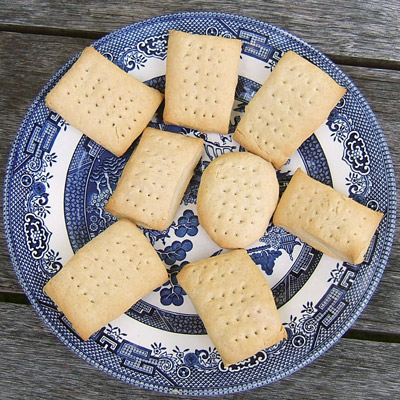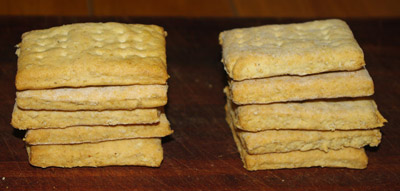Antarctic Sledging Biscuits Recipe
Food from the Deep
South
Cooking sledging biscuits with suggestions on variations,
easy to make.
Food technology,
cookery, science
Sledging biscuits
recipe and context PowerPoint - click to open or download
3.67Mb - 11 slides
Alternate file types, open or
download:
.pdf
.mp4
Sledging biscuits in Antarctica are one of the two foods that Antarctic exploration was built on, (the other is pemmican) they are still in use today, eaten by people who are working away from bases in Antarctica as a dietary staple.
They are derived from hardtack or ships biscuits. A simple, physically resilient, nutritious, long lasting, compact food stuff that is easy to make. It takes the place of bread as the standard carbohydrate source when away from base.
There are a surprising number or ways you can vary the recipe for this simple food, the recipe I used would be similar to that used by Captain Scott on his journey to the South Pole. I can't say it's exactly the same as I can't find a recipe for what he used, in fact recipes for basics such as sledging biscuits and pemmican were sometimes regarded as secrets known to the expedition physician and suppliers of the food only. It wasn't really so important exactly what the recipe was, more so that it was a secret which added to the aura of the expedition. Sledging biscuits were used along with pemmican and snow to make a filling and warming stew known as hoosh.
The Recipe (or rather, A recipe)
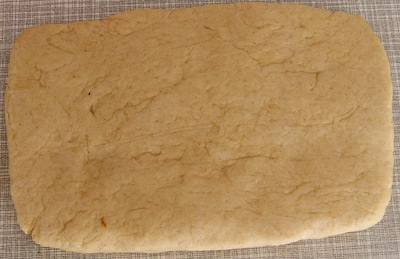 Dough ready to be cut
Dough ready to be cut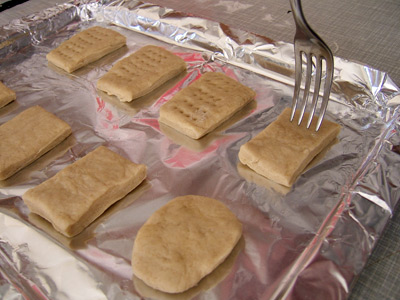 Pricking
the biscuits, this keeps them flat as they cook
Pricking
the biscuits, this keeps them flat as they cook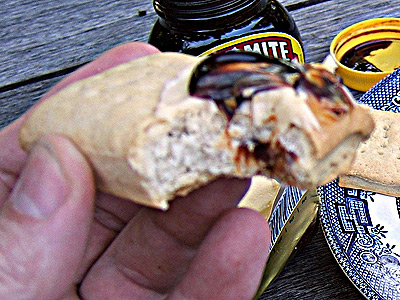 Sledging
biscuit, butter and marmite
Sledging
biscuit, butter and marmite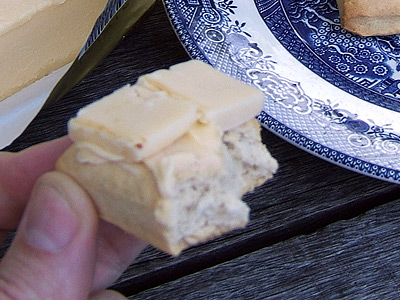 Sledging
biscuit, butter and cheese
Sledging
biscuit, butter and cheese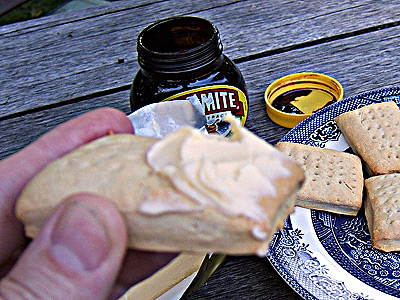 Sledging
biscuit with butter
Sledging
biscuit with butterIngredients
150g plain white flour
1/2 tsp baking
soda
1/2 tsp salt
30g butter (not
nearly-butter, not
butter substitute)
50ml cold water
- Rub the butter and flour together so that it
forms a fine consistent crumb, add the baking soda
and salt and mix well.
- Add a little of the water and knead the mixture
to a soft pliable dough, adding a little water at
a time to get the right consistency, you may not
need all of the water and while you can add more,
you can't remove it.
- Place the ball of dough on a lightly floured
surface and roll it out to around 1cm or just under
half an inch thick and cut into rectangles. I got
8 approx. 5cm x 7.5cm (2" x 3") biscuits from this
amount.
- Prick the surface of the biscuits lightly with
a fork (this stops them ballooning up) and place
on a baking tray, I put foil on mine first as I
wasn't sure how non-stick or otherwise it would
be.
- Place in a pre-heated oven at 190°C. The assorted
instructions I amalgamated to make these biscuits
said for 15 mins and that they should be turning
golden in colour. After 15 mins I thought they needed
a bit more cooking, so gave them another 3 mins,
then I gave them another 5, at each of these three
points they looked almost identical, so it seems
cooking time is not critical and 15-23 mins makes
little difference! Just don't let them get too dark,
they should be quite pale and remember I used white
flour for these if comparing them to yours.
- Take them out of the oven and let them cool.
There are two traditional ways to eat them, firstly as you would a cracker, with lots of butter (more than you're probably used to or are even comfortable with) and maybe marmite (or vegemite) or cheese, and secondly crumbled into a stew with pemmican and water and anything else you might have to flavour it (like melted snow) to make Hoosh.
I had mine with butter, butter + marmite, butter + cheese as well as making hoosh. The purpose of sledging biscuits is to top up with energy during and after a hard day in the field. Even today, people who travel and camp in Antarctica often come back having lost weight. The high fat of this recipe, especially with extra high fat toppings may be a bit of a surprise as we worry so much about what we eat (though eat more unhealthily than ever) but the energy is needed. If you are outdoors in the cold working hard every day and camping out, you really burn through the calories.
Out in the field those toppings I spread on the sledging biscuits would be considered very thin indeed, equal thickness of biscuit and butter/cheese would be more like it.
Authenticity and taste test
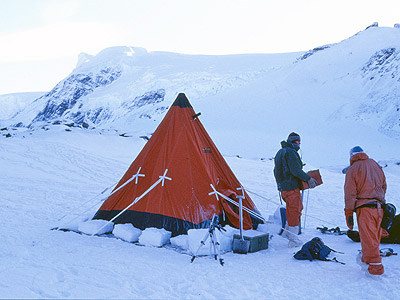 Well they looked authentic enough,
though the baking soda made them rise a little, whereas I remember
sledging biscuits I ate in Antarctica as being thinner and harder.
Well they looked authentic enough,
though the baking soda made them rise a little, whereas I remember
sledging biscuits I ate in Antarctica as being thinner and harder.These that I made were better than I remember, probably as a result of being fresh and not already a year (or 5) old by the time I ate them. They were actually very nice considering the limited ingredients. Sledging biscuits have always been functional rather than consumed by choice. There is only one person I remember in Antarctica who claimed to really like them and would eat one with relish when they were around, though never sought them out when they weren't and no-one believed him anyway. In Antarctica sledging biscuits tend to come in small individually wrapped packs of 5 or so and work out quite expensive for what they are, they are reserved for use off base.
The true authentic experience for me came when I had butter and marmite on a biscuit and unexpectedly, especially as I was sitting out in my English country garden in August, was taken immediately back to sitting in a tent in Antarctica at the end of an exhausting day wrapped up snug in a sleeping bag, propped up on one elbow with the Tilley lamp glowing and hissing overhead and the Primus making another brew of tea for us.
Recipe variations
The fore runners of the sledging biscuit, ships biscuits or hardtack, had no butter, and so the first sledging biscuits were probably similar, simple flat biscuits of flour and salt, shaped with a little water and baked.By the time Antarctic exploration began, extra fat was added for extra energy, and recipes started to vary.
Roald Amundsen for instance used whole meal flour and added oats to make his sledging biscuits much better nutritionally than Scott's, he also omitted baking soda which may actively reduce the levels of some vitamins in the other ingredients.
Skimmed milk powder was also sometimes added to increase the protein, vitamin and mineral levels.
Lesson plan suggestions
Such a simple recipe and important foodstuff for a particular circumstance lends itself to use in teaching especially as it is also so easy to make. It took me about 15 minutes from getting the stuff out of the cupboard to having the biscuits on the tray ready to go in the oven.You could get different students to make different recipes and then do a taste-test comparison as an introduction, then look at the ingredients in more detail researching the full nutritional value of the different combinations, bearing in mind that when away from base for months on end, minerals and vitamins become more critical in all foods eaten as the variety is much less. Roald Amundsen took just 4 foodstuffs, sledging biscuits, pemmican, dried milk and chocolate when he went to the South Pole in 1911, a return journey that took over 3 months, they also eat some of the dogs they took too and had actually put on weight by the time they got back. Vitamins weren't known about at the time, the first one, vitamin A wasn't discovered until 1913 with others found over the next two decades.
Here's some suggestions of combinations you could put together. The biscuits must have some sort of flour and always have salt, there are 16 possible combinations in the table below. I'd suggest the recipe further up the page as it is, the same with wholemeal flour, and then the same with white or wholemeal flour and added oats as being the most palatable and authentic. The taste could be considered alongside the nutritional data.
These biscuits could be compared to hardtack made with just flour and salt, mixed with water and baked.
Each horizontal line is a possible alternative combination of ingredients.
| Flour + Salt | Baking soda | Butter | Other |
| white (120g) | yes | yes | oats (30g) |
| white (120g) | yes | no | oats (30g) |
| white | yes | yes | no |
| white | yes | no | no |
| white (120g) | no | yes | oats (30g) |
| white (120g) | no | no | oats (30g) |
| white | no | yes | no |
| white | no | no | no |
| wholemeal (120g) | yes | yes | oats (30g) |
| wholemeal (120g) | yes | no | oats (30g) |
| wholemeal | yes | yes | no |
| wholemeal | yes | no | no |
| wholemeal (120g) | no | yes | oats (30g) |
| wholemeal (120g) | no | no | oats (30g) |
| wholemeal | no | yes | no |
| wholemeal | no | no | no |

